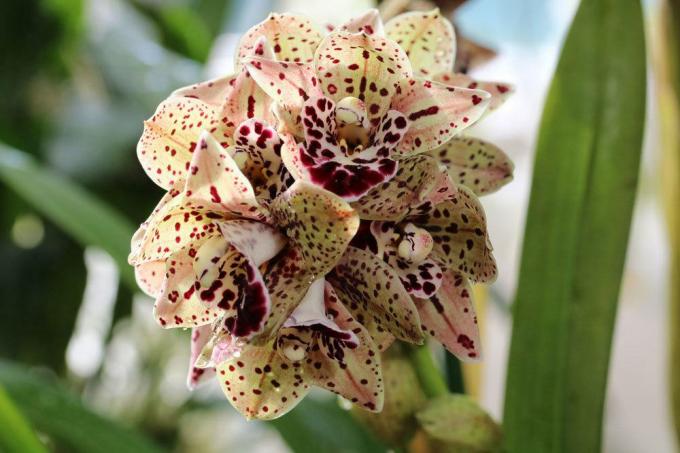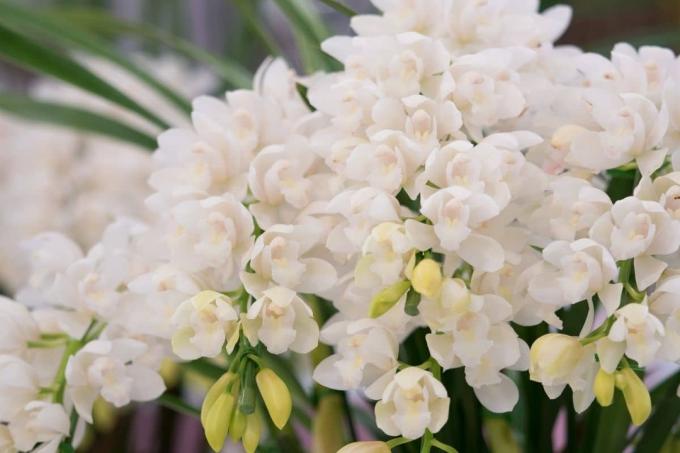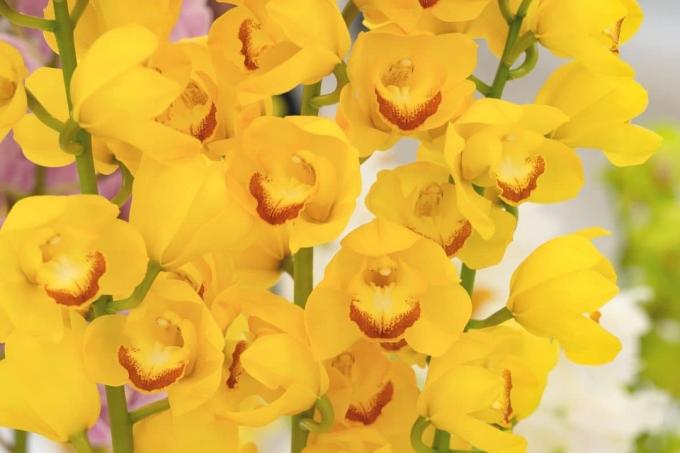
table of contents
- care
- floor
- Fertilize
- to water
- Diseases
- plants
- Pests
- Cut
- Location
- Repot
- Multiply
Profile and care information open +conclude -
- Flower color
- yellow, multicolored, orange, pink, red, violet, white, brown
- Location
- Partial shade, no sun
- Heyday
- January, February, March, October, November, December
- Growth habit
- upright, perennial, perennial
- height
- up to 100 centimeters high
- Soil type
- sandy, gritty
- Soil moisture
- fresh
- Limescale tolerance
- Calcium intolerant
- humus
- low in humus
- Poisonous
- no
- Plant families
- Orchids, Orchidaceae
- Plant species
- Potted plants, house plants
- Garden style
- Pot garden, winter garden, residential garden
The Cymbidium Orchid owes its name to the shape of its decorative flowers. With their curved, boat-like lips, they are reminiscent of a boat, which means “kymbos” in Greek. The beauty is native to Thailand, Burma and northern India, as well as Australia and Indonesia. In the local latitudes, hybrids are offered in the trade, which are particularly suitable for indoor culture due to their crossings. With the right care, the Cymbidium will bloom in the most beautiful colors.
care
The Cymbidium orchid is not easy to care for. Especially if it is to develop its decorative flowers from scratch every year, it must be given the best possible conditions. Depending on the species, the flowers, up to thirteen centimeters in size, bloom in many colors and give off a pleasant scent. The right care to make the orchids bloom is explained below.
floor
The soil must be well-drained, hard, firm soil does not tolerate the decorative plant. Especially because it does not tolerate waterlogging. The roots in the soil used should also be well aerated. Therefore, the suitable substrate looks like this:
- often cultivated in rock wool
- A bark and peat mixture is also ideal
- it is easier to use commercially available orchid soil
- here the earth for Phalaenopsis use

Fertilize
Fertilizing the decorative plants is very easy, because this happens together with the watering process. In order to make the orchids bloom, they need a weekly fertilization during the growth phase. Commercial, special orchid fertilizer in liquid form contains everything the plant needs. When dosing, it is essential to pay attention to the manufacturer's instructions.
to water
Cymbidium orchids need a lot of water and moisture, which should always be fresh. Because the decorative plants do not tolerate water that has been standing for a long time in the pot and thus waterlogging. The orchid also enjoys regular spraying from above, especially when it is open in summer The sheltered balcony has been relocated.Otherwise, you should pay attention to the following when pouring will:
- lime incompatible
- therefore use captured rainwater
- alternatively filtered tap water
- Water more frequently during the growth phase
- Let dry between the individual pouring processes
- only water again when the surface is dry
- do not leave any water in the collecting plate
Once the pseudobulbs and new leaves have developed and matured, there is less watering.
Diseases
Diseases in the Cymbidium orchid are usually due to incorrect care. The orchid does not bloom, then it is because it was too warm during the budding period. In order to make them bloom again next year, the temperature will be switched to 14 ° Celsius or less next autumn. Increased fertilization and watering in summer also stimulates the formation of buds. But watering and the resulting waterlogging to be avoided can cause another disease, root rot. You should proceed as follows:
- Repot the orchid immediately
- take from the pot
- remove all old substrate
- Carefully cut off damaged roots
- let dry easily
- Clean the vessel well
- Apply drainage
- Fill in fresh substrate
- Insert the plant

Only after a few days, when the plant has recovered, start watering and let it drain well. Unfortunately, it is not always possible to save an orchid infected with root rot. But it's always worth a try.
plants
Orchids from the trade are always offered in a pot. But even if the plant is to remain cultivated in a container in the apartment, it should be moved to a new container soon after purchase. Because the pots in which the plants are sold are usually not filled with the ideal substrate, also it is mostly about cheap plastic pots, from which the Cymbidium in a short time grows out. When planting, the following should be done:
- Create drainage against waterlogging
- for this purpose expanded clay or pottery shards over the drainage hole
- plant fleece above
- Fill in part of the fresh substrate
- Take the plant out of the pot
- Clean the roots well from the soil and shake off
- put in a vessel
- Fill in the remaining substrate
- pour and drain
Pests
Spider mites like to sit on the decorative plants outdoors in summer. Daily spraying from above helps against this, as it can prevent infestation. An insecticide and careful rubbing of the leaves with a damp cloth help against the unpleasant pests. The following pests occur in particular in indoor culture:
- Scale insects
- Thrispe
- Mealybugs and mealybugs
- Red spider
In such cases, the plant is too dry in the apartment, the humidity should be increased. The insects are carefully removed from the leaves with a damp cloth, and the orchid is then treated with insecticides. Treat the soil as well, as larvae and eggs of the various pests could also be found here. If you want to be absolutely sure, replace the substrate and clean the container well inside and out.
Peel the older bulbs
If there are older bulbs on the orchid, then these should be peeled so that possible fungal or pest infestation and rot can be prevented. The decorative appearance of the hybrids is also increased in this way, the plant looks more well-groomed. You should proceed as follows:
- Cut off old, dried up leaves directly above the bulb
- tear the last remainder in the middle
- pull it off from the outside inwards bit by bit
Cut
Cymbidium does not require pruning, as is known from other plants. It is only important that the dead flowers are removed regularly. If you like, you can also cut off flower stalks for a bouquet with a sharp and disinfected knife. However, this is only recommended if the plant has a lot of flowers, as otherwise it would look “plucked”.

Location
The ideal location for the Cymbidium orchid is bright without direct sunlight, especially the midday sun should be avoided. In winter, the location should be cooler, but definitely protected. In summer, the hybrids can also move into the garden, terrace or balcony. However, they should not stand here in the rain or in the blazing sun. The ideal locations are therefore as follows:
- in winter on a windowsill
- a cool room is ideal
- Bedroom or stairwell
- Protect from direct sunlight
- North window is well suited
- covered outdoor corner in summer
- enough light without direct sunlight
An unheated winter garden is ideal for the orchid, here it can be kept in a bright location all year round. This is because the unheated winter garden is warm enough in summer and so cool in winter that the decorative plant will develop its beautiful flowers.
Repot
The Cymbidium orchids can become very large and, above all, they also grow very quickly. Therefore, the plants have to be repotted regularly at least every two years, in which case they need relatively large containers. The right time to repot is therefore as follows:
- as soon as the tubers grow over the edge
- because the orchid feels comfortable in narrow vessels
- the best time to do this is after flowering
- Take the plant out of the pot
- remove old substrate by shaking it off
- insert in a new container
- proceed as under “Plants”
Multiply
The orchids are propagated by dividing; as soon as more than six bulbs appear on the plant, propagation can be carried out. The right time for this is the day of repotting, as the plant must be removed from the container for this. When dividing the cymbidium, the following should be used:
- Remove old substrate from roots
- Roots can be very firm and dense
- a simple knife is not enough here for sharing
- Ideally, use a hand saw to help
- this should be sharp and disinfected
- otherwise bacteria and fungi could invade the plant
- each section should have three to four bulbs
- also about at least one new shoot
After dividing, the orchids are each placed in their own new containers, proceeding here as under “Plants”.

Bring it to bloom
In order to get the decorative orchids to bloom, they need the right temperature above all. So that the buds do not fall off before the flowering period in winter and spring, the temperature should be 14 ° Celsius, or even cooler. The orchid will not bloom if too many buds fall off due to excessively high temperatures. The flowers are located on peduncles up to 13 cm long, which grow between the long, narrow leaves and so often exceed the size of the orchid. Just before and during the flowering period, attention should be paid to the following circumstances:
- cool location from October
- bright at a window
- Bedroom or stairwell are ideal
- if buds open, it can get a little warmer
- then temperatures around 16 ° Celsius are recommended
If the bulbs are ripe in summer between the long, narrow leaves, then the orchid needs a little more water to be added, which also stimulates the formation of flowers. Regular fertilization in summer is also important for later flower formation.



